Forget 2010: The Poverty Olympics are here and now
They sang, they marched, they ran the Welfare Hurdles. If the Downtown Eastside has one luxury, it’s the wealth of its humanity
THE CITY: A BIWEEKLY LOOK AT LIFE IN VANCOUVER
TIMOTHY TAYLOR
Globe and Mail
February 11, 2008
A piece of street art went up in Blood Alley recently that caught my attention: a dumpster papered over with exacting detail to render it perfectly as a piece of Louis Vuitton luggage.
It’s recognizable immediately as the work of the Vancouver artist Cameraman. And like his Eastside Culture Crawl alarm clock which I wrote about late last year, the Vuitton Dumpster was highly time and location specific.
As far as site goes, it’s no accident the artist has chosen to set up this ironic wink at the delusions of luxury on the Downtown Eastside, that most un-luxurious zone of our urban matrix, but also the newest, hottest target of gentrifying forces.
The timing, however, gave the piece special poignancy, appearing as it did early on the morning of a particularly auspicious Sunday in sport, that of both the 42nd Super Bowl and the first annual Poverty Olympics in Vancouver. If the two coincide again next year, I encourage you all to turn out for the Poverty Olympics, which makes for the more enriching spectator event.
The brainchild of the Carnegie Community Action Project, the Poverty Olympics are explicitly about social housing and welfare policies. But playing out as a hybrid of street theatre and political satire, aping and mocking the 2010 Olympic Games, almost all the events had tongue planted firmly in cheek.
There was the torch procession, headed up by the Poverty Olympic mascots: Itchy the Bedbug, Chewy the Rat and Creepy the Cockroach.
Surrounded by a smallish crowd, the trio made their way from the Vancouver Area Network of Drug Users offices, west through bemused traffic on Hastings Street to the Carnegie Centre, marching in ragged step behind a man playing John Philip Sousa marches on a tiny battery-powered saxophone.
The mood carried on inside, with events such as the Welfare Hurdles, highlighting new regulations making it more difficult for people to access welfare, and the Poverty Line High Jump, illustrating various all-too-plausible scenarios – job loss, injury – in which people at risk of poverty might find themselves falling below even that extremely low level of income.
Over all this, organizer Alan James kept up a distinctly sardonic patter, mocking 2010 expenses such as the billions being spent on the Richmond-Airport-Vancouver link and highway improvements which, as he pointed out, won’t help Downtown Eastside residents much: “Like we go to the airport.”
The crowd loved all this, hugely. There was much laughter throughout. And there were waves of boos and cries of “Shame!” each time the Mr. VANOC villain character – complete with black cape and mustachio – appeared from the stage wings to berate the crowd.
Of course, the root message remains deadly serious. Centrally, Carnegie activists want welfare and minimum wage rates raised, and they want the 3,500 units of social housing built as laid out in the city’s own Homelessness Action Plan of 2005.
For its part, the city recently announced 1,200 units of “supportive housing” and the mayor’s website lists some 850 low-income housing units either built or under construction, with more than 1,300 approved and in development.
But the numbers are murky, according to Carnegie activists Jean Swanson and Wendy
Pedersen.
There are projects listed as new that are actually renovations or have been brought in from other budget areas, such as health care. The low-income units from the Woodward’s and Southeast False Creek developments are both overstated, they claim. And of those 1,200 units of housing intended to make such an impact on homelessness before the Olympics, it seems only 600 or so will even be built in that time.
“Sometimes I think we need a forensic auditor to figure out these numbers,” Ms. Pedersen said.
Vancouverites want homelessness addressed. City Hall has expressed an interest in doing so as a 2010 legacy. Let’s have some clarity here so people can judge if we’re succeeding or failing.
In the meantime, it may be instructive for civic policy makers to attend the next Poverty Olympics, where it is so easy to see why this destitute neighbourhood is so worth intervening to save.
They might encounter, like I did, the emotional heart of the event when the speakers suddenly blared out the famous Depression-era tune from the film Gold Diggers of 1933, while volunteers threw handfuls of play money around the room and the whole audience sings, “We’re in the money, come on, my honey. Let’s lend it, spend it, send it rolling along.”
It was a Vuitton Dumpster moment. Ironic, yes. But full of genuine community, too. In this case: a jam-packed room full of people from a place where, for all its grinding poverty and advertised addiction problems, it is still possible to find something as luxuriously beautiful as a shared song.
Try that in Yaletown.
Timothy Taylor is a novelist and journalist based in Vancouver. His latest book is the novel Story House.
